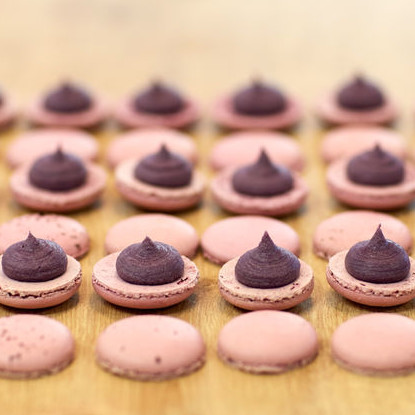
Fillings
What are Fillings?
Fillings are key ingredients in many bakery products such as creams, fondants, chocolate, truffles, pralines, caramels and many more. They are incorporated into a variety of pastries and desserts such as donuts, layer cakes, eclairs, pies, turnovers, sandwich-cookies or savory baked goods to impart unique:
- Color
- Taste
- Texture
For the best performance, fillings should be stable during storage, shelf life and baking.
Function
Bakery fillings are used to create a desired texture, sweetness, firmness, adhesion, shelf life, or ease of pumping/injection, among other properties.
Types of fillings
Various types of fillings are used in commercial baking and food production, such as:
- Creams: typically made of superfine sugar, shortening or oil, corn syrup, water, polysorbate 60, salt, flavors, gums and other minor ingredients. Examples of this type are basic creams, custard- and cheese-based creams, or dulce de leche.
- Chocolate ganache, fudges and marshmallows
- Fruit-based fillings: as well as adding sweetness, fruit pastes are used for functional and health benefits. For example, plums contain sorbitol, which provides subtle sweetness and can boost the fiber content of cookies. Figs are rich in gallic acid, while dates contain high levels of chlorogenic acid and procatechuic acid. Fruit-based fillings contain gelling agents such as alginates.1
- Nut and seed-based fillings: these are often ground to a very fine particle size or made into a spread, such as the popular chocolate hazelnut spread.
Processing
Cream fillings are usually produced near the filling stations to make sure they are consistent for the application. They can be applied to bakery products via depositing or injection.
- Deposition: a typical example is sandwich cookies processed using machines commonly known as cookie cappers. These units pull cookies from the end of the cooling conveyor, align them in rows and flip them over prior to depositing the fillings. Then, they place the top cookie to form a sandwich. The system can also be designed to feed the sandwiches directly to a chocolate enrobing line.2
- Injection: a typical example of filling injection is the Twinkies miniature cakes. After baking and cooling, the cakes are released from the trays and turned upside down. Next, they pass through a series of cream-filling injectors where injection heads simultaneously pierce the bottom of the cake and fill it with the cream prior to packaging.
Application
- The processability of filling creams is a function of the amount and fineness of sugar and other dry ingredients, as well as the type of fats used and its crystallization behavior.
- Filler fat shortenings should be firm to provide support to the cookies or wafers and should not snap or squeeze out when pressed or broken.
- The shortening must completely melt in the mouth at body temperature to avoid waxy mouth feel. Low solid fat content at low temperature, good thermal stability without oiling out or sticking and a short plastic range are desirable characteristics of a good filler shortening. Typically, a ratio of 60:40 of partially hydrogenated fat to vegetable oil and 1 to 5 percent emulsifier are used in filler shortenings.
- One important aspect of fruit pastes is controlling their brix (°Bx). Dry fruit fillings in the pH range of 3.3–3.5 with 75–80°Bx remain spreadable during baking. Higher °Bx fillings harden especially during storage.1
- Fillings should have low water activity (below 0.68) to ensure adequate microbiological quality and shelf life as well as retard moisture migration from the filling to the baked shell/cookie.3
FDA Regulation
Because typical fillings do not contain any actual cream, the FDA requires that Oreos and similar products be labeled “creme”-filled instead of cream-filled.
References
- Mahapatra, A., Shashirekha, M.N. and Sudha, M.L. Characterization and bake stability of dry fruit fillings in dehydrated chiku (Manilkara L.P. Royen) incorporated biscuits. J. Texture Stud., 2017, 48, 93, pp: 231-240.
- Davidson, I. Biscuit, Cookie and Cracker Production: process, Production and Packaging Equipment. 1st Edition. 2018, Academic Press, pp. 226.
- James, P.,Smith, D., Daifas, P., El-Khoury, W., Koukoutsis, J. and El-Khoury, A. 2010. Shelf life and safety concerns of bakery products. Crit. Rev. in Food Sci Nutr., 44, 1, pp: 19-55.

